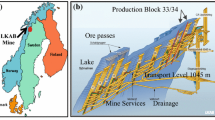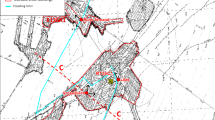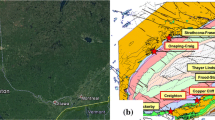Abstract
With the aim of understanding the nature of mining-induced seismicity, microseismic activity in the deep metal mine of Garpenberg (Sweden) has been recorded during 2 years of excavations. The studied area of the mine is operated using sublevel stoping method with backfilling, between depths of around 1000 and 1300 meters. Spatiotemporal analysis of microseismic activity is presented and correlated with the occurrence of mining blasts. A clear dependence is observed between blasts and seismic sequences, even if the rock mass response to mining appears to be very variable across space and time. Two main clusters are observed: one located in the major production area (Central Cluster), while the second (Right Cluster) is located at some distance from the excavations, in a zone characterized by a heterogeneous distribution of weak materials and stiff rock masses. By analyzing seismic source parameters, we demonstrate that the two clusters are characterized by different dynamics. In addition, we show how Right Cluster events are mainly controlled by geological heterogeneities, which impose high stress concentrations in the stiff rock masses surrounding weak lenses. High apparent stresses and corner frequencies associated with the Right Cluster events agree with our proposed model. This suggests elevated stresses in the seismic source region and small source dimensions; indeed, fractures cannot propagate along great distances due to the presence of weak lenses interbedded with the breaking stiff rock mass.

















Similar content being viewed by others
References
Allen, R., Bull, S., Ripa, M., & Jonsson, R. (2003). Regional stratigraphy, basin evolution, and the setting of stratabound Zn–Pb–Cu–Ag–Au Deposits in Bergslagen, Sweden (Final report SGU-FoU project 03-1203/99).
Bourouis, S., & Bernard, P. (2007). Evidence for coupled seismic and aseismic fault slip during water injection in the geothermal site of Soultz (France), and implications for seismogenic transients. Geophysical Journal International, 169, 723–732.
Brown, L., & Hudyma, M. (2017). Identification of stress change within a rock mass through apparent stress of local seismic events. Rock Mechanics and Rock Engineering, 50, 81–88.
Brune, J. N. (1970). Tectonic stress and the spectra of seismic shear waves from earthquakes. Journal of Geophysical Research, 75, 4997–5009.
Contrucci, I., Klein, E., Bigarre, P., Lizeur, A., Lomax, A., & Bennani, M. (2010). Management of post-mining large-scale ground failures: Blast swarms field experiment for calibration of permanent microseismic early-warning systems. Pure and Applied Geophysics, 167, 43–62.
Cook, N. G. W. (1976). Seismicity associated with mining. Engineering Geology, 10, 99–122.
Dahm, T., Becker, D., Bischoff, M., Cesca, S., Dost, B., Fritschen, R., et al. (2013). Recommendation for the discrimination of human-related and natural seismicity. Journal of Seismology, 17, 197–202.
De Santis, F., Contrucci, I., Lizeur, A., Tonnellier, A., Matrullo, E., Bernard, P., & Nyström, A. (2017). Numerical approach for evaluating microseismic array performances: case study of a deep metal mine monitoring network. In Proceedings of the 9th international symposium on rockbursts and seismicity in mines.
Eshelby, J.D. (1957). The determination of the elastic field of an ellipsoidal inclusion, and related problems. In Proceedings of the royal society of London A: Mathematical, physical and engineering sciences (pp. 376–396). The Royal Society.
Feustel, A. J. (1998). Seismic attenuation in underground mines: a comparative evaluation of methods and results. Tectonophysics, 289, 31–49.
Gibowicz, S. J. (2009). Seismicity induced by mining: Recent research. Advances in geophysics (pp. 1–53). Oxford: Elsevier.
Gibowicz, S. J., & Kijko, A. (1994). An introduction to mining seismology. New York: Academic.
Hudyma, M.R. (2009). Analysis and interpretation of clusters of seismic events in mines (PhD thesis). University of Western Australia Perth.
Hudyma, M., & Potvin, Y. H. (2010). An engineering approach to seismic risk management in hardrock mines. Rock Mechanics and Rock Engineering, 43, 891–906.
Jansson, N. (2011). The origin of iron ores in Bergslagen, Sweden, and their relationships with polymetallic sulphide ores (PhD thesis). Luleå University of Technology.
Kanamori, H. (1977). The energy release in great earthquakes. Journal of Geophysical Research, 82, 2981–2987.
Kijko, A. (1986). Theoretical model for a relationship between mining seismicity and excavation area. Acta Geophysica Polonica, 33, 231–241.
Kinscher, J.L. (2015). The analysis and interpretation of microseismicity induced by a collapsing solution mining cavity: A contribution for progress in hazard assessment of underground cavities (PhD thesis). Université de Lorraine.
Kwiatek, G., & Ben-Zion, Y. (2013). Assessment of P and S wave energy radiated from very small shear-tensile seismic events in a deep South African mine. Journal of Geophysical Research: Solid Earth, 118, 3630–3641.
Kwiatek, G., Plenkers, K., Dresen, G., & Group JR. (2011). Source parameters of picoseismicity recorded at Mponeng deep gold mine, South Africa: Implications for scaling relations. Bulletin of the Seismological Society of America, 101, 2592–2608.
Lomax, A., Virieux, J., Volant, P., & Berge-Thierry, C. (2000). Probabilistic earthquake location in 3D and layered models. Advances in Seismic Event Location (pp. 101–134). Berlin: Springer.
Madariaga, R. (1976). Dynamics of an expanding circular fault. Bulletin of the Seismological Society of America, 66, 639–666.
McGarr, A. (1976). Seismic moments and volume changes. Journal of Geophysical Research, 81, 1487–1494.
Mendecki, A. J., Van Aswegen, G., & Mountfort, P. (1999). A guide to routine seismic monitoring in mines. A handbook on rock engineering practice for tabular hard rock mines (Vol. 35). Cape Town: Creda Communication.
Naoi, M., Nakatani, M., Igarashi, T., Otsuki, K., Yabe, Y., Kgarume, T., et al. (2015). Unexpectedly frequent occurrence of very small repeating earthquakes (- 5.1 ≤ M w ≤ - 3.6) in a South African gold mine: Implications for monitoring intraplate faults. Journal of Geophysical Research: Solid Earth, 120, 8478–8493.
Olivier, G., Brenguier, F., Campillo, M., Roux, P., Shapiro, N. M., & Lynch, R. (2015). Investigation of coseismic and postseismic processes using in situ measurements of seismic velocity variations in an underground mine. Geophysical Research Letters, 42, 9261–9269.
Pasolini, C. (2008). The attenuation of seismic intensity (PhD thesis). Università di Bologna.
Richardson, E., & Jordan, T. H. (2002). Seismicity in deep gold mines of South Africa: Implications for tectonic earthquakes. Bulletin of the Seismological Society of America, 92, 1766–1782.
Stec, K. (2007). Characteristics of seismic activity of the Upper Silesian Coal Basin in Poland. Geophysical Journal International, 168, 757–768.
Stork, A. L., Verdon, J. P., & Kendall, J.-M. (2014). The robustness of seismic moment and magnitudes estimated using spectral analysis. Geophysical Prospecting, 62, 862–878.
Tarantola, A., & Valette, B. (1982). Generalized nonlinear inverse problems solved using the least squares criterion. Reviews of Geophysics, 20, 219–232.
Tonnellier, A., Bouffier, C., Renaud, V., Bigarré, P., Mozaffari, S., Nyström, A., et al. (2016). Proceedings of the eighth international symposium on ground support in mining and underground constructions. In E. Nordlund, et al. (Eds.), International symposium on ground support in mining and underground constructions. Luleå: University of Technology.
Vallejos, J. A., & McKinnon, S. D. (2011). Correlations between mining and seismicity for re-entry protocol development. International Journal of Rock Mechanics and Mining Sciences, 48, 616–625.
Van Aswegen, G., & Butler, A. G. (1993). Applications of quantitative seismology in South African gold mines. Proceedings of the 3rd international symposium on rockbursts and seismicity in mines (pp. 261–266). Rotterdam: AA Balkema.
Wyss, M., & Brune, J. N. (1968). Seismic moment, stress, and source dimensions for earthquakes in the California-Nevada region. Journal of Geophysical Research, 73, 4681–4694.
Acknowledgements
Authors would like to thank Boliden engineers Shahram Mozaffari, Anders Nyström and Peter Fjellström for their support underground the mine and for all the information shared during the project. We gratefully thank Boliden geologists Johan Olsson, Lena Lilja and Michaela Seliö, for discussion and information about local geology in the mine, which significantly helped in improving this work. We also want to thank Boliden and Ineris technical staff for their assistance on the site and with data management. Finally, we thank two anonymous reviewers, and Tomas Fischer the editor, who helped improving this manuscript.
Author information
Authors and Affiliations
Corresponding author
Rights and permissions
About this article
Cite this article
De Santis, F., Contrucci, I., Kinscher, J. et al. Impact of Geological Heterogeneities on Induced-Seismicity in a Deep Sublevel Stoping Mine. Pure Appl. Geophys. 176, 697–717 (2019). https://doi.org/10.1007/s00024-018-2020-9
Received:
Revised:
Accepted:
Published:
Issue Date:
DOI: https://doi.org/10.1007/s00024-018-2020-9




